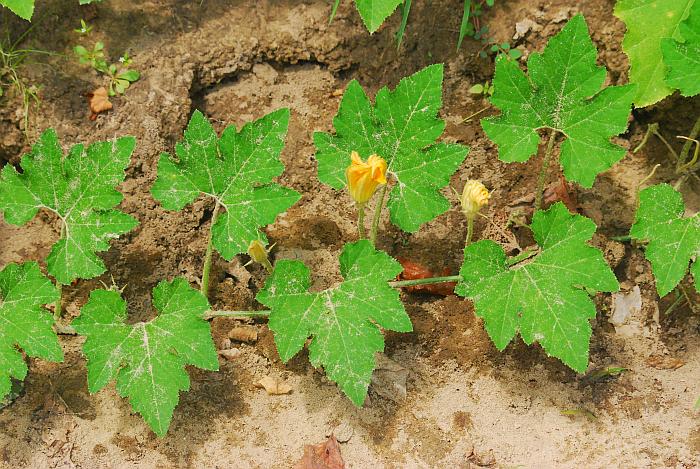Cucurbita pepo L.
Yellow-Flowered Gourd

Native
CC = Amb
CW = 5
MOC = 11
© SRTurner
Cucurbita pepo L.Yellow-Flowered Gourd | |
 |
Native CC = Amb CW = 5 MOC = 11 |
© SRTurner |
|
Family - Cucurbitaceae Stems - Trailing or climbing, to 5 m, stout, hollow between nodes, coarsely roughened with stout, pustular-based hairs, with branched tendrils.
Leaves - Alternate, long-petiolate, the petioles coarsely roughened with stout, pustular-based hairs. Leaf blades ovate to nearly circular in outline, to 30 cm broad, 3-5 lobed, margins finely toothed, surfaces roughened with pustular-based hairs.
Flowers - Plants monoecious. Flowers usually solitary in leaf axils. Staminate flowers with longer stalks than pistillate flowers. Calyx lobes 9-20 mm long. Corollas 5-10 cm wide, deeply bell-shaped, 5-lobed, yellow to yellowish orange. Staminate flowers with the filaments fused into a tube except sometimes at the very base, the anthers fused into a headlike mass. Pistillate flowers with 3 staminodes, the hypanthium and calyx moderately to densely hairy, the ovary with numerous ovules per placenta, the stigma 3-5-lobed or more or less 6-10-lobed.
Fruits - Solitary, modified berries 5-8 cm long, spherical or pear-shaped, with a pulpy, fibrous central portion, at least when young and a relatively thin, hardened shell, indehiscent, with a stalk 15-40 mm long, the surface glabrous at maturity, green, sometimes with irregular, longitudinal, lighter-colored stripes, becoming bleached to an ivory color at maturity. Seeds numerous, 6-10 mm long, elliptic to obovate in outline, flattened, smooth.
Flowering - August - October. Habitat - Forests, streambanks, sloughs, disturbed areas. Origin - Native to the U.S. Lookalikes - Other species of Cucurbita and Cucumis. Other info. - This is the wild type of a complex which also includes numerous squashes and gourds. It is encountered only sporadically and uncommonly in Missouri, having been collected from a dozen or so widely scattered counties in the southern half of the state. It is easily recognized by its growth habit and large orange flowers. Fruits from this species complex have been used by humans since antiquity for a number of purposes, including food; however, the fruits of the wild type are usually bitter. Photographs taken along the Meramec River south of Route 66 State Park, St. Louis County, MO, 8-14-2011, and at West Tyson County Park, St. Louis County, MO, 8-6-2012 (SRTurner). |